
Rediscovering Japan

Rediscovering Japan
Seasonal Events (March)

by tomizuta
Hinamatsuri
Hinamatsuri is a festival for girls to pray for their well-being on every
3rd March. My wife kindly agreed about Hinamatsuri from her past experience.
![]()
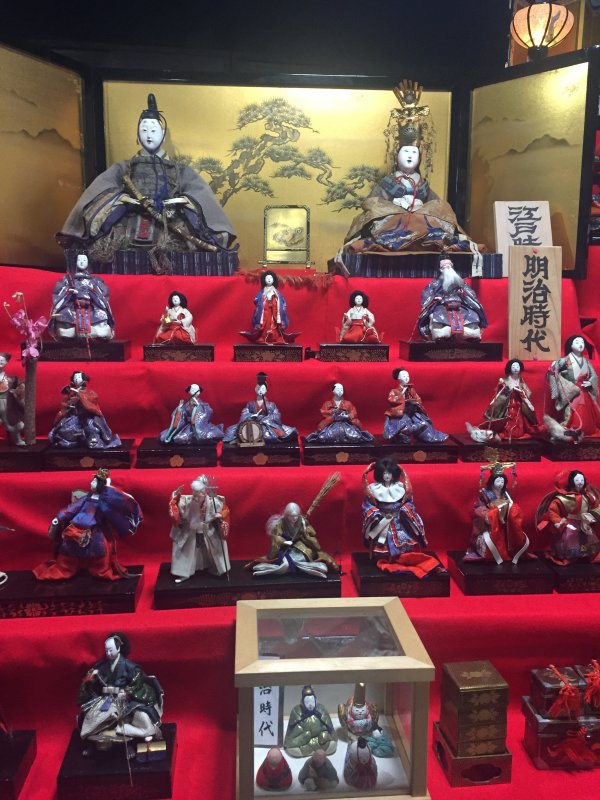 Following Setsubun in February comes the time to display the dolls for
Hinamatsuri. On a sunny day you would bring out the large carton box containing
the dolls. You then take out of the carton box the smaller doll boxes.
The dolls have been carefully stowed with their faces covered with paper
and then wrapped with smooth linen. You place the dolls together with their
props one by one on a stand covered by a large red cloth. I was very proud
of the sword prop which has a sheath from which the sword could be taken
out. But you are not allowed to play with the dolls. Once they had been
displayed you were told not to touch them. So the day you took the dolls
out from their boxes for display was a particularly enjoyable day for me.
Hinamatsuri was typically celebrated within households with daughters.
Following Setsubun in February comes the time to display the dolls for
Hinamatsuri. On a sunny day you would bring out the large carton box containing
the dolls. You then take out of the carton box the smaller doll boxes.
The dolls have been carefully stowed with their faces covered with paper
and then wrapped with smooth linen. You place the dolls together with their
props one by one on a stand covered by a large red cloth. I was very proud
of the sword prop which has a sheath from which the sword could be taken
out. But you are not allowed to play with the dolls. Once they had been
displayed you were told not to touch them. So the day you took the dolls
out from their boxes for display was a particularly enjoyable day for me.
Hinamatsuri was typically celebrated within households with daughters.
(Left: Hina dolls from the Edo and Meiji era)
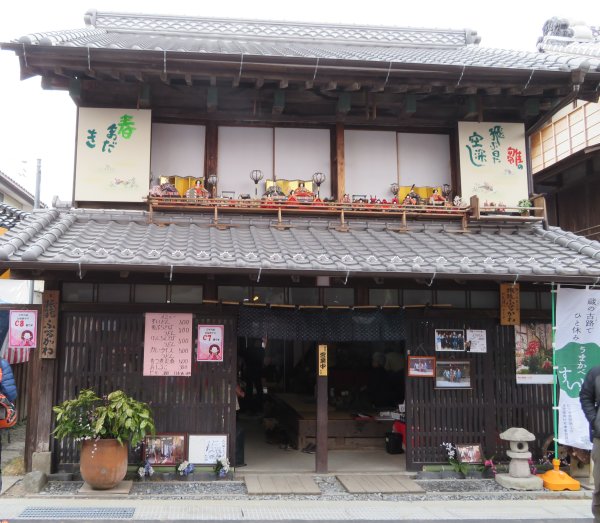 Nowadays, more and more villages and towns have started to celebrate Hinamatsuri
in the communities as an effort to attract visitors and revitalize the
areas. This is a new style of Hinamatsuri that has emerged from the need
to stimulate the local economy combined with the changing circumstances
in the family i.e. nuclear families with fewer children.
Nowadays, more and more villages and towns have started to celebrate Hinamatsuri
in the communities as an effort to attract visitors and revitalize the
areas. This is a new style of Hinamatsuri that has emerged from the need
to stimulate the local economy combined with the changing circumstances
in the family i.e. nuclear families with fewer children.
( Left: On the second floor of a restaurant in Makabe, hina dolls were
displayed as part of the community hinamatsuri event)
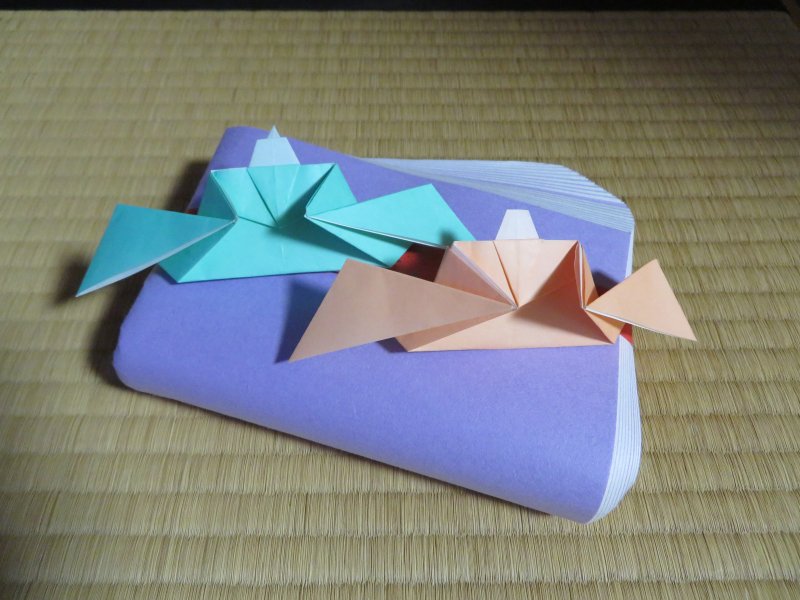 The great-grandmothers of todayfs children were in their girlhood around
WWII. There werenft that many afforded with hina dolls, and even fewer
dolls survived through the war. Hundreds of hina dolls are displayed at
communitiesf hinamatsuri events, but there are very few that are from the
early Showa era (1926 to roughly the 1930s) or earlier. Poor as they were,
they were not able to have their own hina dolls, but they still celebrated
hinamatsuri with hina dolls made of colored paper (origami) or other affordable
materials, drank amazake (see article on Asakusa for amazake) and had chirashi-sushi
together with clear clam soup, cherishing and preserving the classical
celebration to pray for the wellbeing of the daughters.
The great-grandmothers of todayfs children were in their girlhood around
WWII. There werenft that many afforded with hina dolls, and even fewer
dolls survived through the war. Hundreds of hina dolls are displayed at
communitiesf hinamatsuri events, but there are very few that are from the
early Showa era (1926 to roughly the 1930s) or earlier. Poor as they were,
they were not able to have their own hina dolls, but they still celebrated
hinamatsuri with hina dolls made of colored paper (origami) or other affordable
materials, drank amazake (see article on Asakusa for amazake) and had chirashi-sushi
together with clear clam soup, cherishing and preserving the classical
celebration to pray for the wellbeing of the daughters.
(Left: Poor as they were, the great-grandmothers were not able to have
their own hina dolls, but they still celebrated hinamatsuri with hina dolls
made of colored paper (origami))
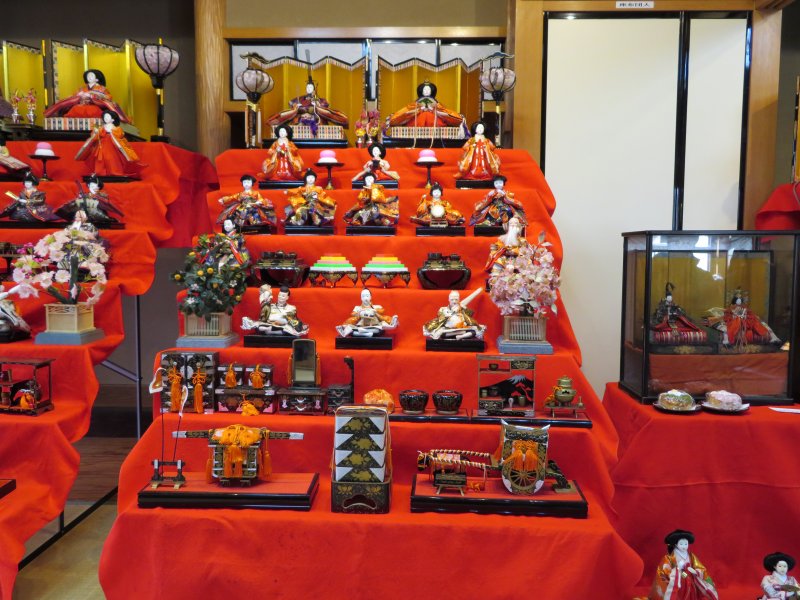 When the great-grandmothers become mothers, Japan had entered a period
of economic expansion of more than thirty years. They wished to let their
daughters have hina dolls that they had never been able to. From this period
hina displays got grander. Seven bench display with fifteen dolls and dowry
or seventeen dolls) became the norm in place of the five or seven bench
display. The majority of the hina dolls displayed at the communitiesf hinamatsuri
are from this period of 1960s to 70s.
When the great-grandmothers become mothers, Japan had entered a period
of economic expansion of more than thirty years. They wished to let their
daughters have hina dolls that they had never been able to. From this period
hina displays got grander. Seven bench display with fifteen dolls and dowry
or seventeen dolls) became the norm in place of the five or seven bench
display. The majority of the hina dolls displayed at the communitiesf hinamatsuri
are from this period of 1960s to 70s.
(Left: A seven bench hinamatsuri display with fifteen dolls and dowry.)
(Note: There are several types of displaying
the dolls for Hinamatsuri. One is a flat display and the other bench display.
The latter takes up more space, so more common in larger houses. The number of
benches can be three, five or seven. In case of a five bench display, the bride
and bridegroom would be on the top, the three servant maids on the second, the
five musicians on the third, the bridefs dowry on the fourth and the dowry
container boxes and the ox-cart at the bottom. The bulk of the present day
hinamatsuri doll sets are priced in the $2,000 to $3,000 range.
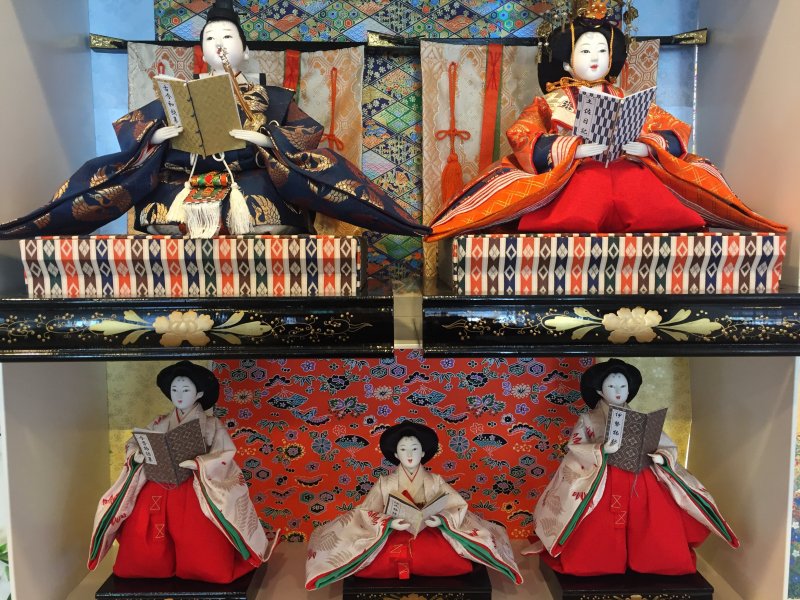 The age of the booming economy saw the rapid growth of nuclear families.
Families from the countryside moved in to smaller houses in the towns and
dual income became more prevalent. They did not have the time to spend
a day to take the dolls out of the boxes and display. The compact one layer
shinnou kazari (with only the bride and bridegroom) became more popular
for the post war generation.
The age of the booming economy saw the rapid growth of nuclear families.
Families from the countryside moved in to smaller houses in the towns and
dual income became more prevalent. They did not have the time to spend
a day to take the dolls out of the boxes and display. The compact one layer
shinnou kazari (with only the bride and bridegroom) became more popular
for the post war generation.
(Left: The hina dolls displayed in the Makabe City library were reading
classics from the past)
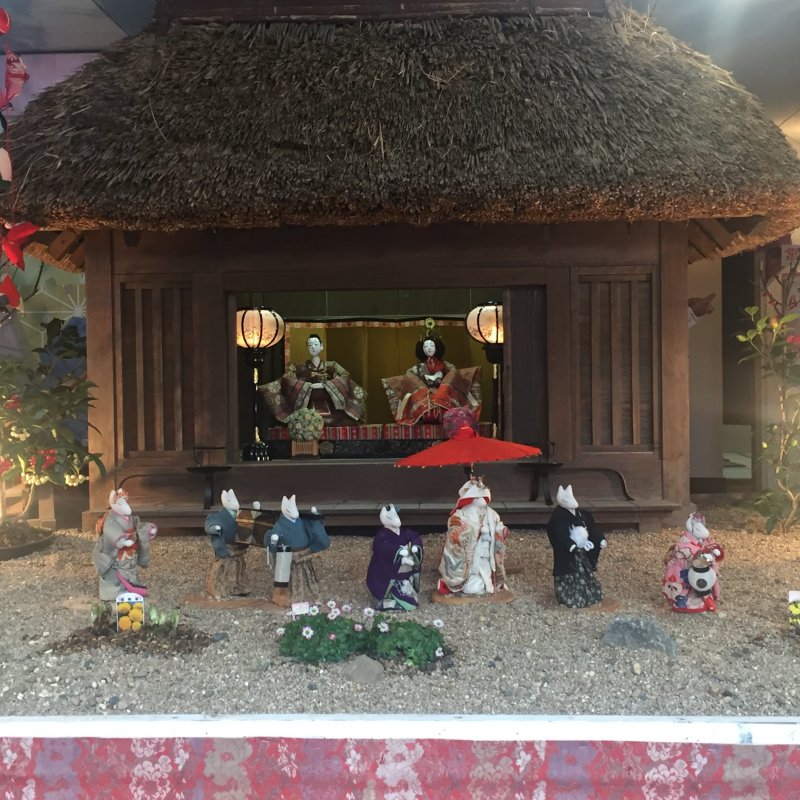 If you google ghinamatsurih, gwho purchases?h appears relatively higher
in the Google Suggested auto-complete. Which grandparents should provide
the hina dolls can be a heated discussion leading to quarrels between mother
and mother-in-law. Some of the complaints are, gItfs always my parents
that have to pay for the granddaughterh (parent), gThe parents ignore our
recommendations as to which hina dolls are best suited for the granddaughterh
(grandparents), gThe hina dolls set that our grandparents bought is too
large for us to manageh (parents) and gItfs always the parents that decide
what to buy, and we are just asked to foot the billsh. The hina dolls for
celebration would become a matter of family quarrel.
If you google ghinamatsurih, gwho purchases?h appears relatively higher
in the Google Suggested auto-complete. Which grandparents should provide
the hina dolls can be a heated discussion leading to quarrels between mother
and mother-in-law. Some of the complaints are, gItfs always my parents
that have to pay for the granddaughterh (parent), gThe parents ignore our
recommendations as to which hina dolls are best suited for the granddaughterh
(grandparents), gThe hina dolls set that our grandparents bought is too
large for us to manageh (parents) and gItfs always the parents that decide
what to buy, and we are just asked to foot the billsh. The hina dolls for
celebration would become a matter of family quarrel.
(Left: Marriage of a female fox. It is said that on a sunny day you have
a drizzle. The display depicts that scene, A masterpiece of a modern artist.)
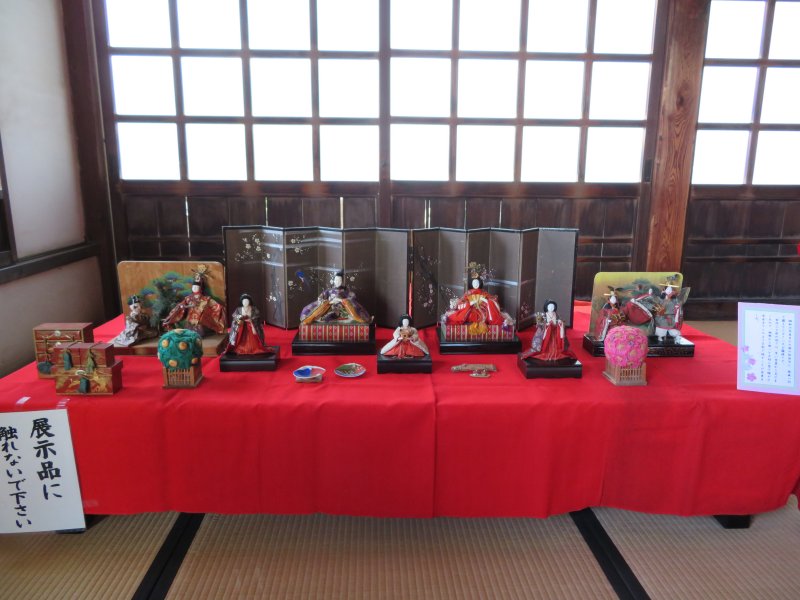 The daughters, when they get married leave their hina dolls with their
parents if they do not have the space in their new homes. This has created
the situation that hina dolls of several generations have been kept in
storage in the warehouses of prominent families in the countryside. The
dolls that had been sleeping surfaced to see the light of day again after
so many years.
The daughters, when they get married leave their hina dolls with their
parents if they do not have the space in their new homes. This has created
the situation that hina dolls of several generations have been kept in
storage in the warehouses of prominent families in the countryside. The
dolls that had been sleeping surfaced to see the light of day again after
so many years.
(Left: Hina display from the early Showa era at Ara-gyoudou of Nakayama Hokkekyou Temple. . Observe the Noh platforms
at both sides.)
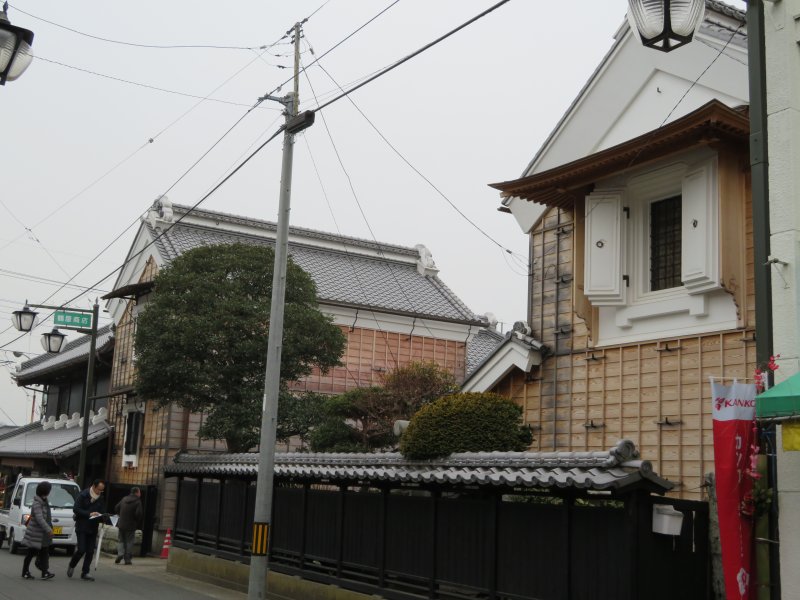 We went to a Hinamatsuri event in the Makabe district, now part of Sakuragawa
City in Ibaraki Prefecture. During the one month event period, the local
shops as well as private houses join the event to welcome visitors to view
their hina dolls. One local resident told us that they had found hina dolls
from the Edo period in their warehouse that they had never known of. Hina
dolls from the pre-WWII period are scarce. Many were lost in the war. It
was pleasing to hear from people older than me say gItfs quite a task to
store and display them every year, but so many people coming to see them
is a real pat on the back for us to continue!h Another local resident told
us gI took out my hina dolls and props as well as my daughterfs. My grandchildren
said that they didnft need such grand displays.h It really is fun chatting
with the residents, drinking amazake (see article on Asakusa) and enjoying
the stroll through the district.
We went to a Hinamatsuri event in the Makabe district, now part of Sakuragawa
City in Ibaraki Prefecture. During the one month event period, the local
shops as well as private houses join the event to welcome visitors to view
their hina dolls. One local resident told us that they had found hina dolls
from the Edo period in their warehouse that they had never known of. Hina
dolls from the pre-WWII period are scarce. Many were lost in the war. It
was pleasing to hear from people older than me say gItfs quite a task to
store and display them every year, but so many people coming to see them
is a real pat on the back for us to continue!h Another local resident told
us gI took out my hina dolls and props as well as my daughterfs. My grandchildren
said that they didnft need such grand displays.h It really is fun chatting
with the residents, drinking amazake (see article on Asakusa) and enjoying
the stroll through the district.
(Left: The center of Makabe has been designated as an Important Preservation District for Groups of Historic Buildings)
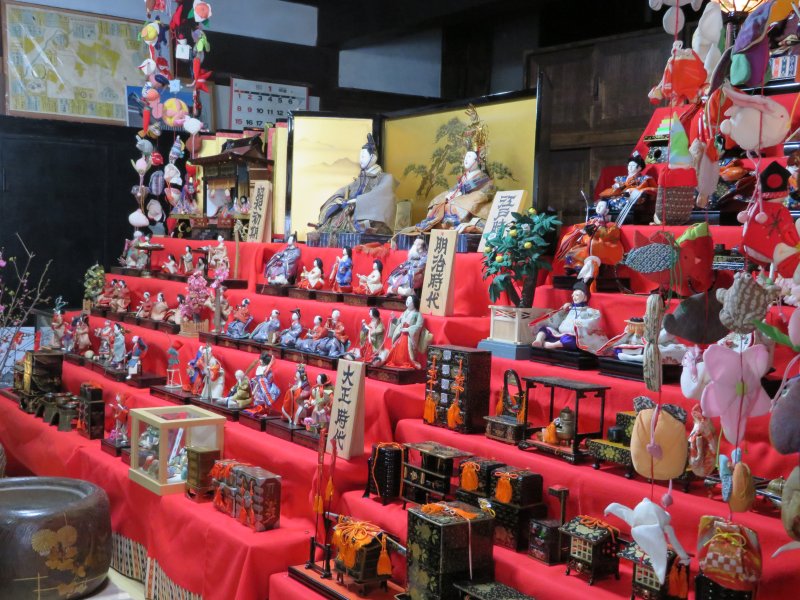 Hinamatsurifs origin is believed to be a tradition where people would rub
their bodies with paper dolls wishing that the dolls would take over all
unlucks and evil from them and then send the dolls downstream into a river
in an act to purify themselves. By the early Edo era (1603-1868), hinamatsuri
had become a family festival within the hiuse to display dolls in a wedding
ceremony and wish for a good marriage for the daughters. And now it is
again becoming an outdoor event of the rural communities.
Hinamatsurifs origin is believed to be a tradition where people would rub
their bodies with paper dolls wishing that the dolls would take over all
unlucks and evil from them and then send the dolls downstream into a river
in an act to purify themselves. By the early Edo era (1603-1868), hinamatsuri
had become a family festival within the hiuse to display dolls in a wedding
ceremony and wish for a good marriage for the daughters. And now it is
again becoming an outdoor event of the rural communities.
Note: We can trace back the start of Hinamatsuri to the Heian Era (8th
to 12th century), so in any event it is an old tradition. It is believed
that by the end of the 15th century, it became customary to celebrate Hinamtsuri
at the March 3rd Sekku (For Sekku please refer to the article on January)
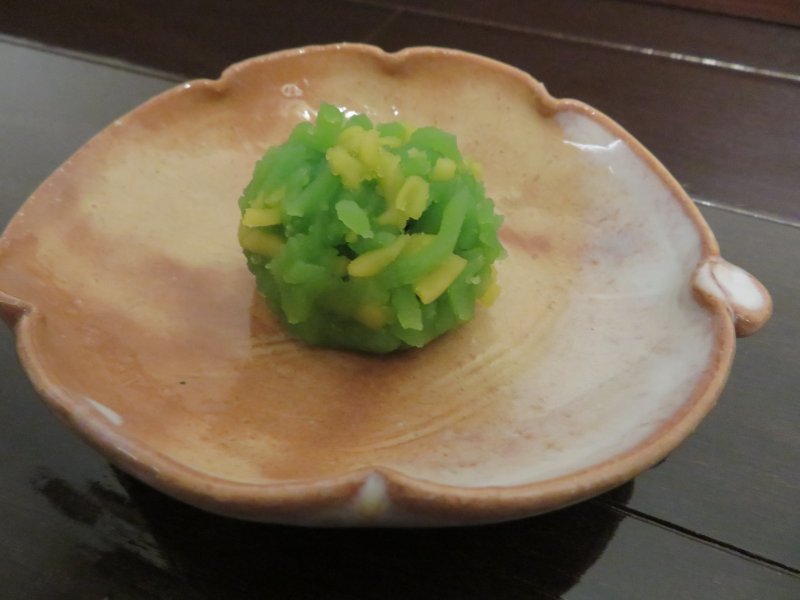 And this is the sweets of the month depicting canola flowers at the start
of spring.
And this is the sweets of the month depicting canola flowers at the start
of spring.